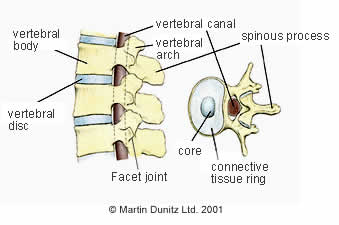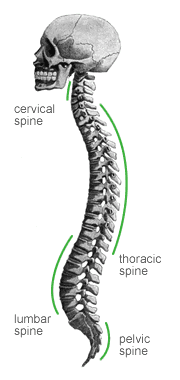| Common Signs & Symptoms | |||||
| Pain | Swelling | Stiffness | Weakness | Instability | Locking |
Facet Syndrome Injury Explained
Facet syndrome can cause back pain either after a severe acute episode, such as a car crash or a hard fall or jolt, which traumatises the Facet joint. More often, Facet pain, or Facet Syndrome is chronic in nature – that is, the underlying cause is due to long term changes in the Facet joint that are often associated with repeated overuse, posture or load, which can lead to degenerative disc disease.
The Facet joints are situated at every level of the spine, on either side of the spinal vertebra, on either side of the spinal column, between the discs and the vertebral bodies. Each vertebra has bony prominences on each side that form a Facet joint with the vertebra above and below. The Facet joints are enclosed within a joint capsule and research has shown that in the lower back there can be a ‘meniscoid’ structure within the joint space, just like a mini version of the meniscus in the knee joint. The role of the Facet joints is to limit excessive movement and provide stability for the spine.

Back pain from the Facet joints may arise from several causes. A severe episode of back pain may be due to sudden excessive movement, which traumatises the Facet joint. Several theories have been put forward, including nipping of the Facet joint capsule or the meniscoid tissue between the two bones. As with trauma to any such joint, there is an inflammatory reaction with swelling and pain in the joint, which may last for several days.
Each Facet joint needs to move and glide on the next, even if only a few degrees, in order for the spinal column to move efficiently. With chronic Facet joint pain, the underlying cause is due to long term changes in the joint, meaning the pain does not go away in a few days. In most cases there is degeneration within the Facet joint, causing an arthritic type problem. This may be a long term consequence of seemingly minor trauma in the past or more likely prolonged poor posture or movement patterns that overload specific levels of the spine.
Facet Syndrome Signs & Symptoms
Typically, there is back pain just to one side of the spine. This is normally made worse by side bending toward the affected side or extending the spine (backward bending). The back will generally feel stiff in the morning. The capsule around the joint can become inflamed and in some cases there may be irritation of the nerve roots, which emerge from the spinal cord at the level of the problem, causing pain to refer to the buttock, groin or hamstring region. This is known as Sciatica. Often this problem is made worse by prolonged sitting or standing in one position.
A doctor or Chartered Physiotherapist is usually able to make a diagnosis based on the history of the condition, and the presence of the signs and symptoms listed above. If there is any doubt it may be necessary to have an x-ray of the spine. A CT scan or MRI scan may also show the problem.
Facet Syndrome Treatment
What you can do
| Consult a sports injury expert | |
| Apply heat therapy to relieve stiffness | |
| Wear a back brace to improve posture & relieve pain |
In the case of a severe episode of Facet joint pain, rest, non-steroidal anti-inflammatory (NSAIDs) drugs prescribed by a doctor, and postural correction with a Chartered Physiotherapist should be adequate as the problem usually only last for a short period. A Heat Pack can be very effective at relieving back pain and muscle spasm.
If a severe problem has been present for more than a week, and there is a limitation of movement, the Chartered Physiotherapist may manipulate the joint with a controlled thrust into spinal rotation. This opens up the Facet joint and breaks down early scar tissue, which may limit movement. This is usually preceded by heat treatment and massage to relax any muscle spasm. A Back Brace can provide reassurance and support to the lower back as the injury resolves.
In a more chronic type of Facet joint problem, the management is more difficult. The treatment outlined above will usually be attempted first, with the Chartered Physiotherapist giving symptomatic relief of the stiffness using Heat Packs and mobilisation techniques. However, where there is persistent pain originating from a Facet joint problem, this has to be addressed. If a conservative approach of physiotherapy and corrective exercise does not work, an injection of long acting local anaesthetic and anti-inflammatory corticosteroid into the Facet joint may be effective in relieving symptoms and, if successful, it confirms the diagnosis. In order for this approach to work the injection is best done by a Consultant Radiologist under an image intensifier. This device allows the doctor to see exactly where the injection is going. This approach can give very good pain relief, but the effects may wear off after a while. It may be necessary to repeat the procedure at a later date. However, for a better long term prognosis corrective exercises and postural improvements need to be made to get to the root cause of the problem and help prevent a relapse.
In cases of Facet Syndrome that cause constant unremitting pain, a more lasting approach for pain relief is a procedure known as Radiofrequency denervation’. Radiofrequency denervation is a technique where the nerves that supply the Facet joint are destroyed by ionizing radiation rather than surgery. This is effective for the relief of pain, but will not stop or reverse the underlying joint degeneration.
Facet Syndrome Prevention
What you can do
| Use a seat support to improve posture whilst sitting | |
| Practise exercises to strengthen spine stabilising muscles |
Poor posture plays a major role in the development of Facet Syndrome. Prolonged sitting and bending postures, where the lumbar spine is ‘flexed’ should be avoided as they increase the pressure on the discs. Positions of side bending can also put excess pressure on the Facet joints and cause excess load and injury. This can lead to disc degeneration and a loss of disc height. As the discs shrink the Facet joints come into contact with each other and start to bear weight. This is not what they are designed to do.
In order to avoid disc degeneration, and loading the Facet joints, it is important to take better care of back posture. An understanding of good posture is necessary to achieve this. Viewed from the side, the spine consists of a series of curves:


The curves increase the load-carrying capability of the spine compared to if the spine was just straight. The lumbar part of the spine consists of a forward curve and as long as this is maintained, posture will be reasonably good, reducing the strain on individual joints and discs. It is important that this improved posture is maintained during all activities, particularly when sitting for long periods – slumping should be avoided. Sitting with cross legs or looking to the side should be avoided as they place asymmetrical stress on the spine. A computer, TV or laptop should be positioned straight in front of the body so you don’t have to sit at an angle.
A Lumbar Roll placed at the bottom of the back or a Seating Support can be effective when sitting to maintain the natural curve of the lumbar spine. Driving for long periods should be avoided if possible and where it is unavoidable regular breaks with stabilising exercises and stretches, particularly in a backwards (extension) motion to counteract the forward position of sitting, can be a good idea.
In the long term, good posture is maintained by increasing the muscular stability of the spine. This can be achieved through specific stabilising exercises known as Core Stability’ exercises. The Stabiliser Pressure Biofeedback Device is very useful at helping to contract the specific muscles that can help the longer term prevention of Facet joint problems and back pain.


